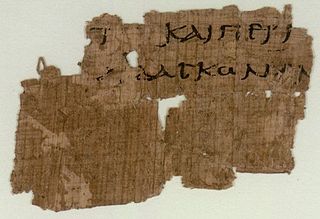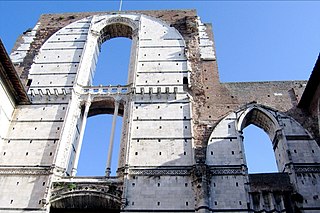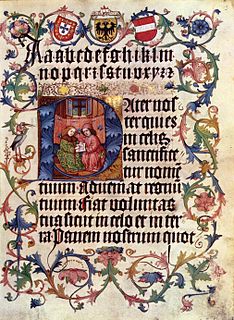This article possibly contains original research .(March 2011) (Learn how and when to remove this template message) |

The saying of Jesus concerning his true relatives is found in the Canonical gospels of Mark and Matthew.
This article possibly contains original research .(March 2011) (Learn how and when to remove this template message) |

The saying of Jesus concerning his true relatives is found in the Canonical gospels of Mark and Matthew.
From Mark 3:31–35:
There came then his brethren and his mother, and, standingwithout, sent unto him, calling him.
And the multitude sat about him, and they said unto him,
Behold, thy mother and thy brethren without seek for thee.
And he answered them, saying, Who is my mother, or my
brethren?
And he looked round about on them which sat about him, and
said, Behold my mother and my brethren!
For whosoever shall do the will of God, the same is my
brother, and my sister, and mother.
From Matthew 12:46–50:
While he yet talked to the people, behold, his mother andhis brethren stood without, desiring to speak with him.
Then one said unto him, Behold, thy mother and thy brethren
stand without, desiring to speak with thee.
But he answered and said unto him that told him, Who is my
mother? and who are my brethren?
And he stretched forth his hand toward his disciples, and
said, Behold my mother and my brethren!
For whosoever shall do the will of my Father which is in
heaven, the same is my brother, and sister, and mother.
A re-organized version also appears in the Gospel of Thomas (Patterson-Meyer Translation):
99 The disciples said to him, "Your brothers and your mother arestanding outside." He said to them, "Those here who do what my Father wants are my brothers and my mother. They are the ones who will enter my Father's kingdom."
100 They showed Jesus a gold coin and said to him, "The Roman
emperor's people demand taxes from us." He said to them, "Give the emperor what belongs to the emperor, give God what belongs to God, and give me what is mine."
101 "Whoever does not hate [father] and mother as I do cannot be
my [disciple], and whoever does [not] love [father and] mother as I do cannot be my [disciple]. For my mother [...], but my true
[mother] gave me life."
Verse 100 (Caesar's Coin) is similar to Mark 12:13-17 and Luke 20.22-26. Verse 101 (Love Jesus/God more than your family) is similar to Matthew 10:37 and Luke 14:26-33.
Jesus' true relatives | ||
| Preceded by Parable of the Strong Man Parables of Jesus | New Testament Events | Succeeded by Parable of the Sower Parables of Jesus |

Zechariah is a figure in the New Testament Bible and the Quran, hence venerated in Christianity and Islam. In the Bible, he is the father of John the Baptist, a priest of the sons of Aaron in the Gospel of Luke (1:67-79), and the husband of Elizabeth who is a relative of the Virgin Mary.

James the Just, or a variation of James, brother of the Lord, was an early leader of the Jerusalem Church of the Apostolic Age, to which Paul was also affiliated. He died in martyrdom in 62 or 69 AD.

The New Testament describes James, Joseph (Joses), Judas (Jude), and Simon as brothers of Jesus. Also mentioned, but not named, are sisters of Jesus. Some scholars argue that these brothers, especially James, held positions of special honor in the early Christian church.
![Sayings of Jesus on the cross 7 sayings of Jesus in the Gospels: “[…] forgive them, for they do not know […]“; “[…] you will be with me in paradise”; “[…] behold your son […]”; “[…] why have you forsaken me?”; “I thirst”; “It is finished”; “[…]](https://upload.wikimedia.org/wikipedia/commons/thumb/f/f9/Brooklyn_Museum_-_What_Our_Lord_Saw_from_the_Cross_%28Ce_que_voyait_Notre-Seigneur_sur_la_Croix%29_-_James_Tissot.jpg/296px-Brooklyn_Museum_-_What_Our_Lord_Saw_from_the_Cross_%28Ce_que_voyait_Notre-Seigneur_sur_la_Croix%29_-_James_Tissot.jpg)
The Sayings of Jesus on the cross are seven expressions biblically attributed to Jesus during his crucifixion. Traditionally, the brief sayings have been called "words". They are gathered from the four Canonical Gospels. Three of the sayings appear only in the Gospel of Luke and three only in the Gospel of John. The other saying appears both in the Gospel of Matthew and the Gospel of Mark. In Matthew and Mark, Jesus cries out to God. In Luke, he forgives his killers, reassures the penitent thief, and commends his spirit to the Father. In John, he speaks to his mother, says he thirsts, and declares the end of his earthly life.
John 20 is the twentieth chapter of the Gospel of John in the Bible. It relates the story of Jesus' resurrection. It relates how Mary Magdalene went to the tomb of Jesus and found it empty. Jesus appears to her and speaks of his resurrection and dispatches Mary to tell the news to the disciples. Jesus then appears to his disciples. The chapter is seemingly the conclusion to the Gospel of John, but it is followed by the somewhat tangential John 21. Most biblical scholars believe John 20 was the original conclusion of the Gospel, and John 21 was a later addition. The events related in John 20 are described somewhat differently in Matthew 28, Mark 16, and Luke 24.

Matthew 4 is the fourth chapter of the Gospel of Matthew in the New Testament. It contains two quite distinct sections: the first half, to verse eleven, is Matthew's account of the Temptation of Jesus by the devil and the second section deals with Jesus' first public preaching and the gathering of his first disciples.

Matthew 5 is the fifth chapter of the Gospel of Matthew in the New Testament. It contains the first portion of the Sermon on the Mount, which will also take up chapter 6, and chapter 7. Portions are similar to the Sermon on the Plain in Luke 6, but much is found only in Matthew.
John 3 is the third chapter of the Gospel of John in the New Testament of the Christian Bible. Baptist preacher Charles Spurgeon said of this chapter that it is the chapter he would choose "to read to a dying man who did not know the gospel, [as] the most suitable one for such an occasion".

Mark 9 is the ninth chapter of the Gospel of Mark in the New Testament of the Christian Bible. It begins with Jesus' prediction that "I tell you the truth, some who are standing here will not taste death before they see that the kingdom of God has come with power". The chapter then recounts the transfiguration of Jesus, a healing miracle, and Jesus' teaching about the return of Elijah, humility and temptation.
The Great Commandment is a name used in the New Testament to describe the first of two commandments cited by Jesus in Matthew 22:35–40 and Mark 12:28–34.

Matthew 28 is the twenty-eighth and final chapter of the Gospel of Matthew in the New Testament. This chapter covers the events around the Resurrection of Jesus and ends with the Great Commission.

The Parable of the Workers in the Vineyard is a parable of Jesus which appears in the Gospel of Matthew in the New Testament.

Jesus' teachings referring to little children and infants/babies appear in several places in the New Testament and in the non-canonical Gospel of Thomas.

Matthew 7 is the seventh chapter of the Gospel of Matthew in the New Testament. The chapter is the last of the three chapters which comprise the Sermon on the Mount.
The New Testament frequently cites Jewish scripture to support the claim of the Early Christians that Jesus of Nazareth is the Messiah, and to support faith in Jesus as the Christ and his imminent expected Second Coming. The majority of these quotations and references are taken from the Book of Isaiah, but they range over the entire corpus of Jewish writings. People of the Jewish faith do not regard any of these as having been fulfilled by Jesus, and in some cases do not regard them as messianic prophecies at all. These either were not prophecies or the verses do not explicitly refer to the Messiah.

"John the Revelator" is a traditional gospel blues call and response song. Music critic Thomas Ward describes it as "one of the most powerful songs in all of pre-war acoustic music ... [which] has been hugely influential to blues performers". American gospel-blues musician Blind Willie Johnson recorded "John the Revelator" in 1930 and subsequently a variety of artists have recorded their renditions of the song, often with variations in the verses and music.
Banishment or exile can be a form of punishment. It means to be away from one's home while either being explicitly refused permission to return and/or being threatened by prison or death upon return. It is a common theme within the Bible, beginning with Adam and Eve. Below is a partial list of these exiles as referenced in the Bible.

Counting the Cost, or in the NIV: The Cost of Being a Disciple or in the NRSV: The Cost of Discipleship or in the NKJV: Leaving All to Follow Christ, are titles given to the Gospel of Luke passage Luke 14:25-33 which includes a pair of parables told by Jesus. The first title comes from the phrase "count the cost", which occurs in the King James Version of the passage, as well as some other versions.
The Quranic account of the disciples of Jesus does not include their names, numbers, or any detailed accounts of their lives. Muslim exegesis, however, more-or-less agrees with the New Testament list and says that the disciples included Peter, Philip, Thomas, Bartholomew, Matthew, Andrew, James, Jude, John and Simon the Zealot. Scholars generally draw a parallel with the disciples of Jesus and the disciples of Muhammad, who followed Muhammad during his lifetime, 600 years later.

Matthew 6 is the sixth chapter of the Gospel of Matthew in the New Testament. This chapter contains the middle portion of the Sermon on the Mount. It includes the Lord's Prayer.